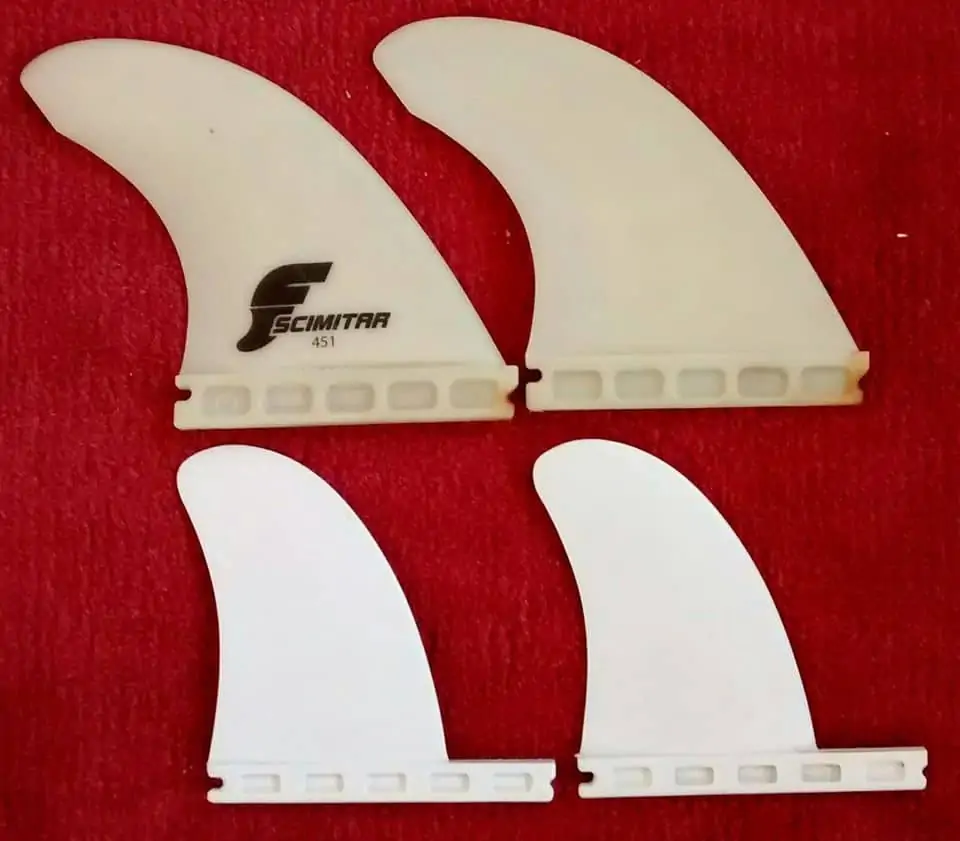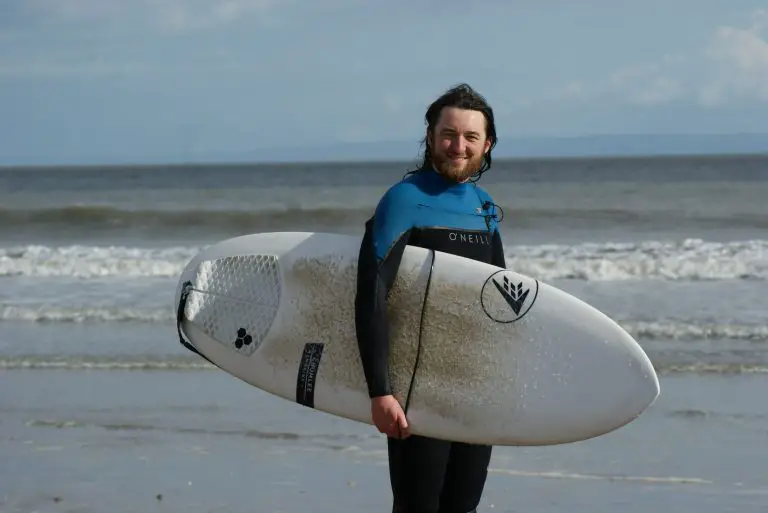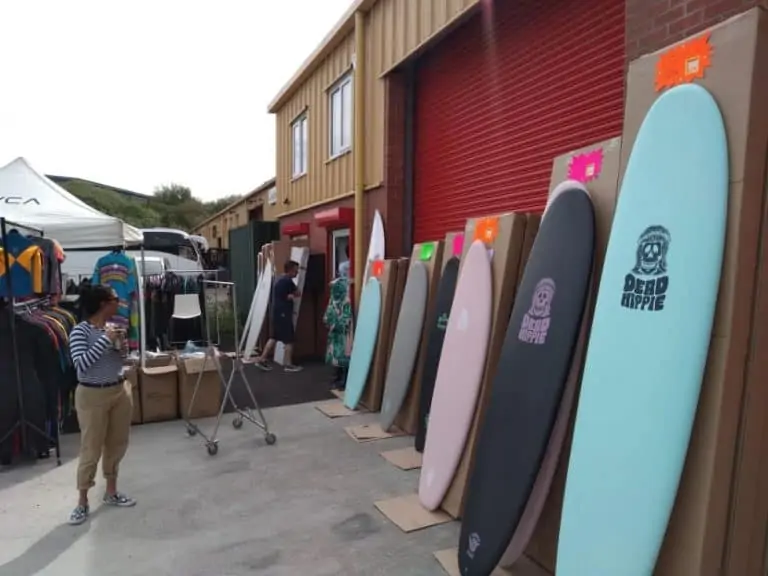First Surfboard After a Foamie – How to Get it RIGHT
After you learn to surf on your first surfboard, which should definitely be a soft-top foam or foamie surfboard, then it can get a little bit tricky to know what board you should buy next.
To answer the question, what is the best first surfboard after a foamie? Drop down to a standard construction polyurethane surfboard at half a foot to one foot shorter than your foamie surfboard.
But, check the volume in liters and don’t go too small on the volume, as I’ll explain below.
Now, that’s the answer in brief, but let’s have a look at this in more detail throughout this post, and help you get that right, first, proper surfboard, after you’ve learnt on a foam soft-top board.
SURFBOARD LENGTH FOR PROGRESSION
So, let’s assume that you’ve bought a foamie surfboard that is two feet longer than you are tall, anywhere from maybe up to nine foot, down to about seven foot. And, you want to get another board to continue your surfing progression.
This is a really normal step, and definitely something you can do if you want to keep going down to smaller boards.
However, before you do, remember that you don’t always have to go for a smaller board, you could just change the construction, and keep a board with a similar template so you can then start to turn it.
One thing to note about foamie surfboards is they’re not designed really for high performance surfing, so they’re not as easy to turn.
So, if you just want to learn to turn, you could just stay with a similar shaped surfboard and get it in a polyurethane or epoxy construction, more of the standard surfboard construction.
This will then help you to progress, and it will also be more fun as you learn how to do different things like bottom turn, maybe even cutbacks in the future.
Also, if you’re wondering how long it takes to learn to surf, check out my dedicated article on that too.
SURFBOARD FINS
One of the biggest differences between a foamie and most other surfboard types is the fins.

Foamies don’t often come with very, quote, unquote, serious fins because they are just for learning.
I know, because my Spooked Kooks Dead Hippie foamie surfboard that I have a lot of fun on, in fact, I rode it this morning, has really small playful fins that are not designed for doing turns on.
However, if I went on to a similar board, that was a similar shape board in an epoxy construction, I can buy all manner of professional fins for it, that will help me to turn it and make it much easier to maneuver.
So, you can start to progress in that way. So, that’s probably the biggest difference if you stayed with the same size surfboard.
But just think about it, and fins, you can customize them and play with them, and really change your surfing just from that one difference on the bottom of your surfboard.
LENGTH OF YOUR SURFBOARD AND PROGRESSION

If you want to progress and keep doing more maneuvers, and get a more maneuverable surfboard, then you should go for a shorter board.
However, this is only for that progression. If you feel really comfortable on your foamie, then stick with a similar size, as I’ve mentioned above.
However, to progress in terms of learning more tricks, go for a board that is six inches to one foot shorter in length, depending on how big your current board feels.
If your board feels just about right but you want to progress, then go for six inches shorter. However, if you feel like it’s really big and cumbersome for you, then go for one that is a foot shorter and see how you feel.
You’ll immediately notice how much harder it is to paddle a board of this size, but then it becomes much easier to start duck diving it.
Although, it’s hard to duck dive any boards that are over seven feet long. However, there’s another factor to consider along with length, as we’ll look at in the next section below.
VOLUME OF SURFBOARDS FOR PROGRESSION

Along with length, you really need to keep an eye on the volume of your surfboards, if you want to progress.
This is because the volume gives you a true indication of the size, if you like, of the surfboard in the water.
Although, you could go for a much shorter surfboard, if it’s fatter, and wider and thicker, then it could actually have a similar volume.
So it will feel very different, in the sense that it’ll be a stubbier board. It’ll float better, but it might not paddle so well. However, volume is a really good overall gauge of the size of your surfboard.
It’s worth keeping a note of the volumes of all the surfboards you have, because then you can see how you like them, how they perform in different ways, and their strengths and weaknesses.
These days, I ride boards that are around 32 to 33 liters in volume, because I often surf them in weak waves. I am 6′ 0″ and about 165 pounds or 75 kilos.
However, I weigh about 10 pounds more in the cold winter surf, because of all the extra wet surfing accessories I have.
So, there’s that factor as well. That said, my foamie fun day surfboard for little waves and just general fun has a volume of about 65 liters.
And, it’s two foot longer than my standard boards.
So, there’s a huge range to think about there, but always keep a note of the volume, so you can get a really good idea of how the board will perform for you.
GET A BOARD WITH A WIDE TEMPLATE AND NOSE
After you’ve learnt on your foamie, you still want a board with a similar template, but maybe a little bit toned down to the foamie.
So, something like Takayama Scorpion is an excellent choice. My wife has one of these, and I often steal it for quick surfs and waves, because it’s so much fun.
It gets into waves really early and easily, and you can turn it because it’s got a crazy tale. But, it’s a lot of fun. But, what you should look for is something with a wide nose and a good amount of volume.
The wide nose means that it causes the board to pick up the wave that much quicker, so you can catch waves really easily, and it just glides through the water.
The last thing you want is to go for a too smaller board with too much of a short board type template, and not be able to catch any waves, because that will sap your motivation.
I mean, you don’t have a lot of fun. When you’re looking for boards to progress with, start to look for ones that have a template that is a little bit more like a hybrid.
You can start to see the big wide round noses of the mals and the mini-mals, then they get a bit more refined.
So, look for those, also in the tail as well. Because the more refined they are, the more you can turn. Now again, this comes back to your aims and goals for your surfing progress.
But, if you want to start learning to turn and do maneuvers in the future, then start going from more refined shapes, but still with plenty of width at this point.
The width will always be proportional, but just use more the volume as a gauge than the actual dimensions, because that will help you.
Combine the volume with the length, and you have a very good idea of how well the board will suit your surfing at this stage.
GET A SURFBOARD CONSTRUCTION THAT SUITS YOU
After your foamie, you will want to get a different construction surfboard with the main two being the epoxy or the polyurethane fiberglass.
There’s lots and lots of different types of construction surfboards boards coming out now, but the main two are these.
The epoxy is nice, because it’s very hard-wearing and it floats extremely well, making it easy to catch waves on.
Whereas a fiberglass board is a little bit softer, it doesn’t wear or last quite as long as an epoxy, but it does have that more forgiving feel to it.
In my experience, an epoxy surfboard can feel a little bit unnatural, a bit rigid, but you probably won’t notice that early on.
And, if you just want an easy way to care for surfboard, an epoxy is definitely the option, because it will last many, many years, and they hold their value for this reason.
However, if you’re looking for a slightly cheaper option and you want more of that softer, more forgiving feel, then a fiberglass polyurethane surfboard is the way to go.
Although, you can get fiberglass PU surfboards with an epoxy skin, so there is a nice hybrid option there if you want it as well.
CHOOSE YOUR NEXT SURFBOARD WITH YOUR GOALS IN MIND
So hopefully, you can find some really good surfboards out there.
In fact, buying a used surfboard is a very good option at this point. But, only buy the right board for you with your own goals in mind.
You don’t have to go down to a tiny short board to enjoy surfing, but if that’s what you want to do and you want to try shortboarding in future, then start cutting down the length.
However, if you just want to get more confident and have more fun, then you can just change the construction and go with a similar template.
But, just think about where you’d like to be in a few years with your surfing, and let that dictate what type of board you buy next to help your progression after your foamie.




